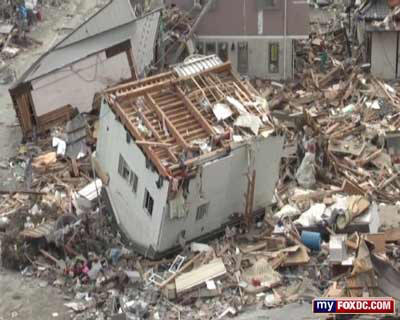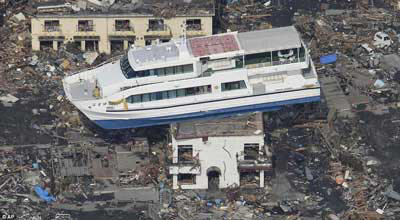GVF has been expanding its work with disaster-response interests to facilitate expanded use of satellite-based systems and services. Recently, in response to requests from our partners in government, at the United Nations, with NetHope -- representing 32 major humanitarian organizations -- and for the GVF Membership, we have been making preparations to launch the Disaster Preparedness Registry. Designed to create a more financially sustainable model for our industry's engagement with disaster-response interests, GVF signed a collaboration agreement with the United Nations Office for the Coordination of Humanitarian Affairs (OCHA) on 8 March to prepare for implementation of the Registry.
At 14:46 local time on March 11, a magnitude 9.0 earthquake struck off the coast of Japan. The massive  earthquake and the tsunami that followed created significant devastation throughout the region, with the water reaching as far as 10km inland. The death toll has now reached 11,500, with 16,400 still listed as missing. The cold weather and fears of radiation from the damaged nuclear plants has impacted the domestic and international response efforts.
earthquake and the tsunami that followed created significant devastation throughout the region, with the water reaching as far as 10km inland. The death toll has now reached 11,500, with 16,400 still listed as missing. The cold weather and fears of radiation from the damaged nuclear plants has impacted the domestic and international response efforts.
The earthquake and tsunami also caused significant damage to the communications infrastructure in the country. The damage was significant to both fixed and mobile communications infrastructure in the affected areas.
The SatCom Industry Responds
Immediately after the earthquake and tsunami struck, GVF began to coordinate with its partners at UN OCHA, companies such as Cisco, the US Government and numerous GVF member companies in anticipation of the need for satellite communication resources for both the restoration of critical communication infrastructure, as well as to enable rescue and humanitarian organizations to communicate abroad. This activity was led by Steve Birnbaum, GVF's Lead for Humanitarian Assistance & Disaster Response.
 Since preparations for the GVF Disaster Preparedness Registry were still underway, we were forced to revert to the reactive method that has traditionally been applied in disaster response. We have been successful in significantly easing the regulatory process needed for approval of VSAT terminals in Japan, despite the fact that it is a highly regulated environment. By Monday, March 14, the GVF had already established a dialog with those responsible for satellite licensing at the Japanese Ministry of Internal Affairs and Communications (MIC). Although Japan is not a signatory to the Tampere Convention -- an international instrument that aims to address regulatory hurdles during disaster-relief efforts -- GVF was able to establish a procedure for rapidly approving license applications for new terminals that will be activated through Japanese companies with whom we have been working.
Since preparations for the GVF Disaster Preparedness Registry were still underway, we were forced to revert to the reactive method that has traditionally been applied in disaster response. We have been successful in significantly easing the regulatory process needed for approval of VSAT terminals in Japan, despite the fact that it is a highly regulated environment. By Monday, March 14, the GVF had already established a dialog with those responsible for satellite licensing at the Japanese Ministry of Internal Affairs and Communications (MIC). Although Japan is not a signatory to the Tampere Convention -- an international instrument that aims to address regulatory hurdles during disaster-relief efforts -- GVF was able to establish a procedure for rapidly approving license applications for new terminals that will be activated through Japanese companies with whom we have been working.
Normally, the process to obtain a license in Japan can run from 3-6 months. The MIC has committed to us that they will process any requests we make within 1-2 days. Since license applications can only be submitted by Japanese companies, we are working with a local partner to act as the service provider. Through satellite operators that possess a local presence in Japan, we will be assisting with the licensing of bandwidth that can then be used by any foreign groups seeking to import and use VSAT terminals under this license.
Once this procedure was in place, we notified NetHope, UN OCHA and others we knew were seeking to deploy teams. We also updated the US State Department, who are providing the required diplomatic coordination for any US-based non-governmental teams deploying to Japan. Finally, we have been conveying offers of support from GVF members to Japanese communications companies and to the MIC.
Changing the Disaster-Recovery Paradigm
In a significant change since previous major disasters, the satellite operators have responded to the GVF’s call to improve the efficiency of disaster response. We are sharing information openly with all satellite industry companies that we know are involved in the Japan response. By sharing information about needs, we have worked with members that include Intelsat, SES, Iridium, Inmarsat, Hughes, iDirect and others to provide a single comprehensive option for NGO use, rather than a multitude of redundant solutions. As the international response to Japan continues to develop, GVF will continue to expand its role in assisting with the global coordination of satellite resources for infrastructure restoration and humanitarian response efforts.
The current status of satellite resources in Japan is that local companies have utilized significant amounts  of their available capacity for government use and infrastructure restoration. However, there have not been requests for telecommunications assistance at this time. Similarly, most foreign NGOs are still performing assessments as to their satellite communication requirements. The latest status of NetHope can be found on their web site. Once these become known, the GVF stands ready to assist anyone needing access to VSAT connectivity in Japan. Furthermore, we invite our members to contact us for any information or assistance with the regulatory authorization process in Japan during the emergency response.
of their available capacity for government use and infrastructure restoration. However, there have not been requests for telecommunications assistance at this time. Similarly, most foreign NGOs are still performing assessments as to their satellite communication requirements. The latest status of NetHope can be found on their web site. Once these become known, the GVF stands ready to assist anyone needing access to VSAT connectivity in Japan. Furthermore, we invite our members to contact us for any information or assistance with the regulatory authorization process in Japan during the emergency response.
The events in Japan underscore the critical importance of preparedness. A significant amount of the early efforts after the disaster struck was spent establishing contact with Japanese companies and assessing available inventory of equipment and bandwidth. Once again, the initial response was reactive. Fortunately, we were able to immediately implement some of the concepts that have been planned for the GVF Disaster Preparedness Registry, but it will be more effective to have these relationships and procedures in place ahead of the next event.
In addition, we continue to gain support from key partners involved in disaster response. The MOU signed with UN OCHA is the most recent. We continue to work with other organizations such as NetHope, governments, the UN and other satcom users to integrate the Registry into their disaster response plans. This will strengthen the link between GVF Member companies and the organizations that will depend upon their systems and services, before, during and after disasters occur.
As critical as advanced planning and preparation is to disaster response, so is exercising response procedures. The GVF has been participating in planning meetings organized by the US Federal Emergency Management Agency (FEMA) for the 2011 US National Level Exercise, an event that will simulate a very large earthquake in the New Madrid seismic zone in the southern and midwestern United States. The National Level Exercise will take place in late May, 2011. We are seeking the participation of member service provider companies with active networks in the New Madrid seismic zone area that meet the criteria set along with the relevant DHS department for the Registry’s role in the exercise. Interested companies should contact us promptly. Likewise, planning has also begun for participation in exercises in other regions of the world, and details will be sent out once available.
The level of interest from our membership in the Disaster Preparedness Registry has been strong, but we now call on those who have not yet confirmed their involvement in the Disaster Preparedness Registry to contact Steve Birnbaum (steve.birnbaum@gvf.org), and express your company’s interest in participating in this important opportunity to improve the way that first responders work with the satellite communications industry.
Sincerely,
David Hartshorn
Secretary General
GVF

